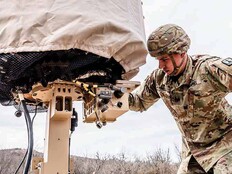Smart Digital Transformation: An Integrated Platform Approach
Gartner notes that “hyperautomation refers to an effective combination of complementary sets of tools that can integrate functional and process silos to automate and augment business processes.” Gartner calls this combination of complementary tools the “DigitalOps toolbox.” The digital operations toolbox includes RPA, process discovery, process mining, business process management and several other technologies referenced in the IDEA Act.
Agencies that achieve a state of hyperautomation can successfully converge these technologies to transform more processes than could ever be done with RPA alone. Those who operate in a state of hyperautomation realize greater operational efficiencies and citizen satisfaction as technology and people work together seamlessly to digitize end-to-end business operations.
Achieving hyperautomation provides a strong foundation for scale. Transforming a complex and manual process into something that’s performed faster and more efficiently many times translates into a collaborative ecosystem of complementary technologies and people working together to enable such an outcome. It’s not, for example, RPA working in a silo, then people checking in sporadically with the hope that nothing’s broken down. This is the basis behind Gartner’s digital operations toolbox; research has been done to identify a robust set of complementary technologies that gives organizations the greatest coverage and ability to transform operations with automation.
Consider the following example of a large federal government contractor that supports the eligibility verification process of the Affordable Care Act health insurance program. This program processes tens of millions of consumer applications each year and deals with 45 million documents annually on behalf of its U.S. government client — and automation plays a key role in almost every one of them.
RPA automates the eligibility verification process, and intelligent, AI-enabled data capturing tools extract data at a massive scale. Analytics capabilities enable monitoring of the processes and workflows. A robotic workforce uses the same case management systems, rules and governance as human employees, but does so up to six times faster, resulting in a tremendous return on investment.
The solution completes as many as 300,000 processes per month, saving substantial labor hours while providing a surge capacity that otherwise would have to be manual. As a result, the program can accommodate regular spikes in processing requirements without hiring the same number of peak-level additional support workers that would otherwise be necessary. Moreover, automation has helped dramatically improve the consistency, accuracy, quality and speed of the program’s work.
MORE FROM FEDTECH: What should agencies consider before deploying artificial intelligence?
The Benefits of Hyperautomation in Government
By deploying a digital operations toolbox, government agencies can better serve constituents, improve federal employee job satisfaction, comply with regulations and drive overall efficiency. This means freeing staff from manual tasks to focus on providing higher-value, more personalized citizen service and replacing slow, paper-based case management with more accurate automated processes, such as capturing, classifying and understanding data at the point of entry from a variety of formats (including handwritten documents and emails).
The use case above also highlights the tremendous value that the automation community can bring to their public sector customers by converging and integrating several technologies within the digital operations toolbox into an integrated platform. Agencies who partner with technology companies like this are better positioned to achieve hyperautomation faster and more efficiently than those who attempt to build their digital operations toolbox with a variety of technology vendors.
Agencies that achieve hyperautomation are best positioned to meet their transformation goals and simultaneously empower their workforces to focus on more meaningful work. Delegating repetitive, low-value tasks that starve agencies of their productivity and effectiveness to an AI-enabled digital workforce is a win for federal employees and for taxpayers.
VIDEO: See how the Defense Logistics Agency uses RPA to enhance its mission.











